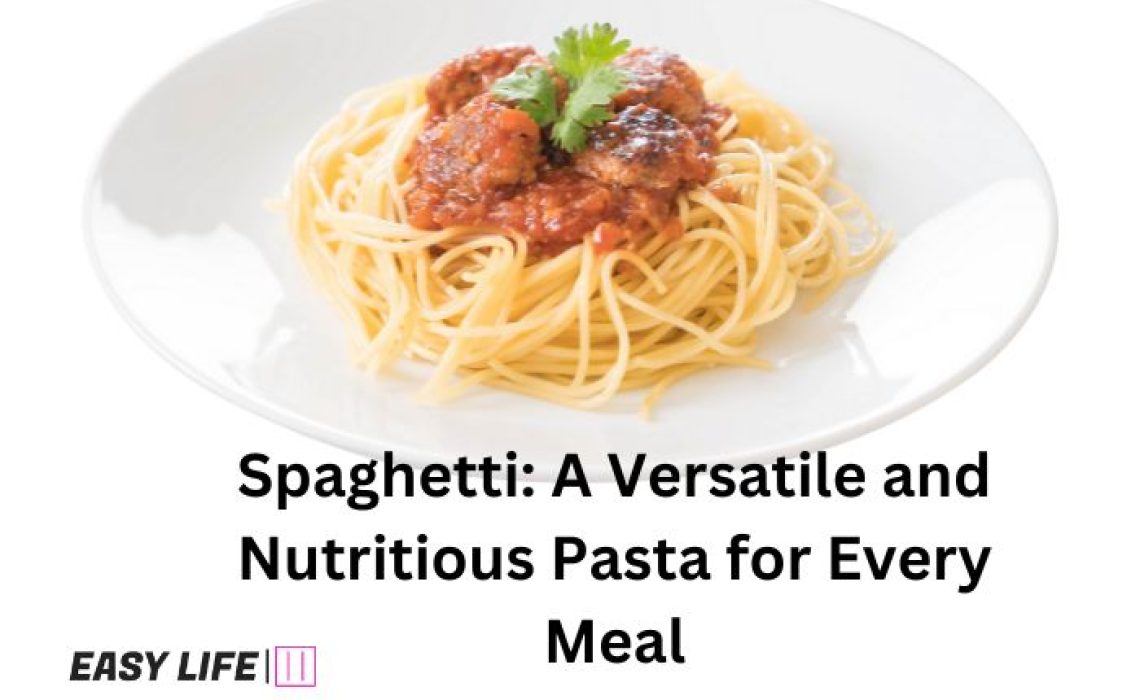People all over the world love spaghetti, which is one of the most famous Italian dishes. Thin, cylindrical noodles are used to make this simple but tasty food. It is usually served with a rich tomato sauce. In this blog, we’ll discuss where spaghetti came from, its health, and other interesting things about this popular dish.
Table of Contents
ToggleWhere Spaghetti Came From
People think that spaghetti came from the city of Naples in southern Italy in the 18th century. It was first made with durum wheat flour, which gave the pasta its yellow colour and firm structure. Over time, spaghetti became more and more popular in Italy and finally became famous all over the world.
What Spaghetti Is Good For You
Carbohydrates, which give the body energy, are found in large amounts in spaghetti. It also has fiber, which is good for the health of your gut system. It is also full of B vitamins like thiamin, riboflavin, and niacin, which are important for staying healthy.
Spaghetti Nutrition Facts
People all throughout the world share a fondness for spaghetti. One cup (140 grams) of cooked spaghetti has the following nutritional breakdown:
221 calories
43 grams of carbohydrates
8 grams of protein
1 gram of fat
2 grams of fiber
Number of sugar molecules: 1
8 milligrams of sodium
It is an excellent source of micronutrients in addition to the aforementioned macronutrients.
Some of the most important nutrients in spaghetti are as follows:
0.30mg of thiamin
Vitamin B2 (riboflavin): 0.1 mcg
Number of milligrams of niacin
Folate level: 65 mcg
1.5 milligrams of iron
Quantity of magnesium: 25 mcg
88 milligrams of phosphorus
Potassium level: 108 mcg
In general, it provides a healthy balance of carbohydrates, protein, and a few key nutrients. In moderate amounts, it is a healthy supplement to a diet because of its low fat and sodium content.
Health Benefits of Spaghetti
It is not only a delicious and versatile dish, but it also offers several health benefits.
Here are some of the key health benefits of this dish:
1. Rich in Carbohydrates:
Carbohydrates, which are found in abundance in spaghetti, are one of the body’s principal fuel sources. Spaghetti’s complex carbohydrates are digested gradually, keeping you going for hours.
2. Contains Fiber:
Dietary fibre, which is crucial for digestive health, may be found in plenty of spaghetti. Constipation is less likely to occur when eating a diet high in fibre.
3. High in B Vitamins:
There are a number of B vitamins included in spaghetti, including thiamin, riboflavin, and niacin. These vitamins are necessary for preserving one’s health and play an important part in the process of converting food into energy.
4. Low in Fat:
It is a fantastic choice for those watching their weight or attempting to eat less saturated fat because of its low-fat content.
5. Provides Essential Minerals:
There are a lot of minerals like iron and calcium in spaghetti. Iron is important for healthy red blood cells, while magnesium is important for strong bones and muscles.
6. Can be a Part of a Balanced Diet:
It is a great base for a healthy meal since it goes well with a wide range of protein sources, vegetable options, and healthy fats. Spaghetti, when part of a well-rounded diet, can contribute to health and wellness by providing a number of important nutrients.
When eaten in moderation and in conjunction with other healthful meals, spaghetti can be a beneficial part of a healthy diet. Spaghetti may be a delightful and filling part of a healthy diet when combined with other nutrient-dense foods.
Related Article: What Happens If You Eat Tacos Everyday | Tacos Dish
Related Article: Healthy Food: Benefits of healthy food
Varieties spaghetti
It is a versatile pasta that can be served in a variety of ways, making it a popular choice for meals around the world. Here are some of the most popular varieties of spaghetti:
1. Classic Spaghetti:
Traditional tomato-based spaghetti sauces often include crushed tomatoes, garlic, and olive oil. Parmesan cheese and herbs are common toppings.
2. Spaghetti Bolognese:
Spaghetti Bolognese is a famous Italian dish made with spaghetti and a tomato sauce made with meat. Usually, the sauce has chopped beef, onion, garlic, and tomato puree in it.
3. Spaghetti Carbonara:
Spaghetti Carbonara is a creamy pasta dish made with spaghetti tossed in a sauce made of eggs, cheese, and bacon. It’s a dish that’s popular in Italy and all over the world.
4. Spaghetti Aglio e Olio:
Spaghetti Aglio e Olio is an easy Italian dish that is often served. To make it, you sauté garlic in olive oil and then toss the spaghetti in the oil and garlic blend. Often, chopped parmesan cheese and red pepper flakes are sprinkled on top.
5. Spaghetti alle Vongole:
A famous Italian dish, Spaghetti alle Vongole is made with spaghetti, clams, garlic, olive oil, and white wine. It’s a popular dish worldwide, especially in seaside areas of Italy.
6. Spaghetti with pesto:
Spaghetti with pesto is a famous Italian dish that consists of spaghetti mixed with a sauce made of basil, garlic, olive oil, and pine nuts. It’s a simple but tasty dish that’s great for a quick dinner.
7. Spaghetti-Puttanesca:
Spaghetti-Puttanesca is a spicy and flavorful food made with pasta tossed in a sauce made of tomatoes, olives, capers, and anchovies. It’s a dish that’s popular in Italy and all over the world.
Pasta, being a form of pasta, has a wide range of potential uses. Whether your preferred sauce is a straightforward tomato sauce or something more elaborate, you may find a pasta dish to suit your tastes.
Interesting Facts about Spaghetti
- The Italian term spaghetti comes from the singular “spaghetto,” meaning “thin string” or “twine.”
- It is typically eaten with a fork and spoon in Italy. The tortellini is twirled on the fork, and the sauce is scooped up with the spoon.
- In 2010, California produced the world’s largest bowl of pasta, which weighed in at over 17,000 pounds.
- The Italian meal known around the world as “pasta and meatballs” was really invented in the United States.
- As part of their space rations, Apollo 11 astronauts in the 1960s ate pasta with meat sauce.
How to Make Spaghetti
It’s pretty easy to make this dish at home, and you only need a few things. For a simple pasta dish, you need:
- Spaghetti noodles
- Tomato sauce
- Garlic Olive oil
- Pepper and salt
Start by cooking the pasta according to the directions on the package until it is “al dente.” While the pasta is cooking, heat the garlic in the olive oil in a big skillet. The garlic should smell good before you add the tomato sauce. Add salt and pepper to taste, then cook the sauce for a few minutes.
When the pasta is done, drain it and add it to the tomato sauce in the pan. Toss the pasta with the sauce until it is thoroughly covered, and serve right away. You can also make the sauce taste better by adding things like meat, veggies, or cheese.
Relate Article: Superfoods: The Secret to Optimal Health and Wellness
Some Questions & Answers related to this topic
Does spaghetti go bad?
Yes, pasta can go bad, just like any other food. But if dry pasta is kept well, it has a long shelf life and can be used for years after its “best by” date.
On the other hand, cooked pasta doesn’t last as long and needs to be kept in the fridge in a container that keeps air out. Most cooked spaghetti will stay good in the fridge for 3–5 days before it starts to go bad.
If you want to know if the pasta has gone bad, look for signs like mould, strange smells, or a slimy feel. If any of these things happen, it’s best to throw out the tortellini to avoid getting sick
why spaghetti is bad for you?
It is a type of pasta made from durum wheat flour and water, and it is usually thought of as a healthy food. However, consuming excessive amounts of pasta, or pairing it with high-fat sauces or toppings, can have negative effects on your health.
Here are a few reasons why you might think spaghetti is bad for you:
- High in carbohydrates: It has a lot of carbs in it, and eating a lot of carbs can make you gain weight and cause other health problems. But small amounts of pasta with healthy toppings or sauces can be part of a healthy diet.
- High in calories: It can be high in calories, especially when served with sauces or toppings that are high in fat. If you eat more calories than you burn in a day, you can gain weight and have other health problems.
- Low in fiber: It doesn’t have much fibre, which is an important food that helps keep your digestive system healthy and can help you stay at a healthy weight.
- May contain gluten: Made with gluten-containing wheat. It can cause gastrointestinal distress and other health problems for those who suffer from celiac disease or are sensitive to gluten.
- May be high in sodium: High blood pressure and other health issues might result from eating too much of certain pasta sauces and toppings.
It’s not inherently bad for you, but you should eat it in moderation and put healthy things on top of it to get the most health benefits.
Can you freeze spaghetti?
- Pasta should be cooked al dente, which means just a little bit firm. Reheating it afterwards won’t turn it into mush if you do this.
- Stop the cooking process and remove extra starch by rinsing the tortellini under cold water.
- Put the pasta in a container or freezer bag that won’t let air in. Make sure to get rid of as much air as you can to avoid freezer burn.
- Put the date and contents on the container’s label.
- Save your spaghetti for up to three months by freezing it.
When you are ready to make use of the frozen spaghetti, remove it from the freezer and allow it to defrost in the refrigerator for a full 24 hours before using it. You may reheat the pasta in the microwave or on the stovetop, and it should retain the same level of flavor as when it was first prepared. But it’s best to only freeze and cook pasta once before putting it in the freezer. Cooking it more than once could make its quality and taste worse.
Conclusion
People have been eating tortellini for hundreds of years because it is tasty and healthy. It is a versatile dish that can be prepared to your liking, whether you prefer a basic tomato sauce or a more involved meat sauce. The possibilities are endless. By following the easy steps in the above recipe, you can make a delicious dish at home that will please your taste buds.










1 thought on “Spaghetti: A Versatile and Nutritious Pasta for Every Meal”
Pingback: Tapas: A Culinary Adventure in Small Bites- Recipes